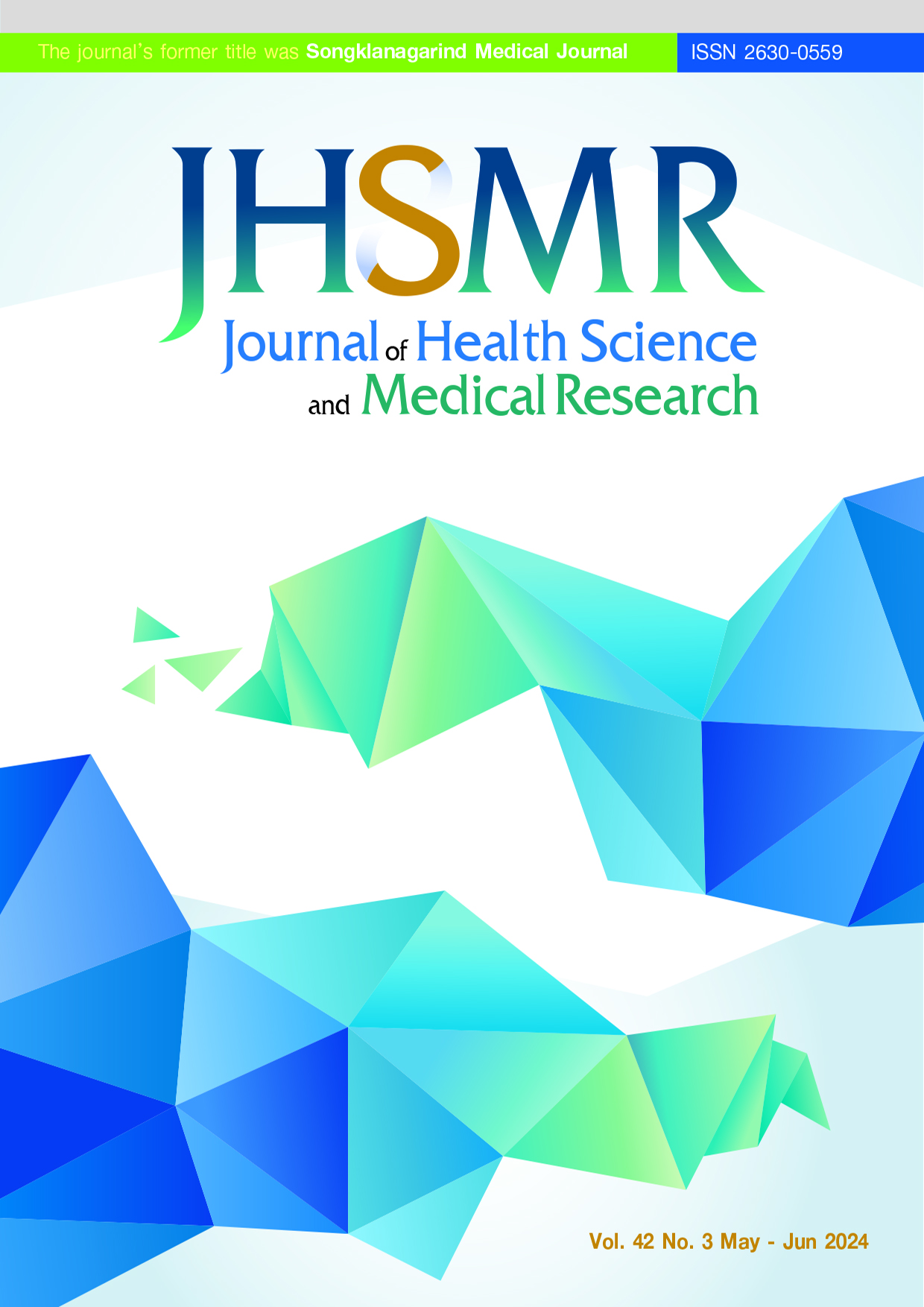Effectiveness of a Developed In-House Breast Phantom in Enhancing the Knowledge of Mammographic Positioning in Radiologic Technology Students: A Quasi-Experimental Study in Thailand
DOI:
https://doi.org/10.31584/jhsmr.20231017Keywords:
breast phantom, educational tool, mammography, positionning, radiologic technology studentAbstract
Objective: This study aimed to develop an in-house breast phantom, and assess students’ knowledge and satisfaction after using it for mammographic positioning training.
Material and Methods: The breast phantom was designed in a half-body shape, and constructed primarily using gelcoat resin, polyurethane foam, and thermoreversible gel. Additionally, silicone type RA-210, known for its high flexibility, tensile strength, elongation at break (620%), and ability to revert to its original shape, was incorporated. This study evaluated the effectiveness of the breast phantom utility in improving students’ knowledge through a nine-item questionnaire; employing a one-group pre-post design. The participants, consisting of 63 Radiologic Technology students, whom rated their satisfaction with the phantom for training purposes using a five-point Likert scale.
Results: The mean knowledge score for the breast phantom positioning significantly improved from 5.35±1.61 points (pretest) to 7.32±1.20 points (post-test), following training (p-value<0.001). The students expressed high overall satisfaction with this training aid (4.49±0.58 points).
Conclusion: Our breast phantom demonstrates its potential as an effective educational tool that enhances Radiologic Technology students’ understanding of mammographic positioning. However, further research is warranted to develop more advanced phantoms and to explore alternative experimental designs for effective teaching methods.
References
Bwanga O. Teaching professionalism to radiography students in the diagnostic imaging. South Asian Res J Appl Med Sci 2019;1:12-5. doi: 10.36346/sarjams.2019.v01i01.003.
Mylopoulos M, Brydges R, Woods NN, Manzone J, Schwartz DL. Preparation for future learning: a missing competency in health professions education?. Medical Education 2016;50:115-23. doi: 10.1111/medu.12893.
Strudwick RM, Taylor K. An investigation into breast imaging as part of the undergraduate (UG) education of diagnostic radiography students in the UK. Radiography 2017;23:141-6. doi: 10.1016/j.radi.2016.12.007.
Dos Reis CS, Pires-Jorge JA, York H, Flaction L, Johansen S, Maehle S. Curricula, attributes and clinical experiences of radiography programs in four European educational institutions. Radiography 2018;24:e61-8. doi: 10.1016/j.radi.2018.03.002.
Gama NV, Ferreira A, Barros-Timmons A. Polyurethane foams: past, present, and future. J Mater 2018;11:1841. doi: 10.3390/ma11101841.
Silicone Shin-Etsu. Characteristic properties of silicone rubber compounds. Silicone, Shin-Etsu. 2012. Available from: https://www.shinetsusilicone-global.com/catalog/pdf/rubber_e.pdf
Bhothisuwan W. Practicing breast imaging in HRT ladies in Thailand. J Med Assoc Thai 2004;87:S169-73.
Borchard W. Properties of thermoreversible gels. Ber Bunsenges Phys Chem. 1998;102:1580–8. doi: 10.1002/bbpc.19981021115.
Chusin T, Mahasaranon S, Udee N, Yabsantia S, Thongprong A. The development of breast phantom for clinical practice in mammography. Srinagarind Med J 2016;31:185–91.
Chusin T, Sandaeng J, Jirakittikool K, Aukusonsomboon S, Mahasaranon S, Thongprong A. Vest style breast phantom for practicing in mammography positioning. TMJ. 2017;17:325–35.
Supertech, Inc. Mammo II Phantom Model RS-750 [homepage on the Internet]. Indiana: Supertech; 2023 [cited 2023 Feb 20]. Available from: https://www.supertechx-ray.com/BreastImagingandMammography/Training/RSDRS-750.php
Roser M, Appel C, Ritchie H. Human height. Our world in data. [monograph on the Internet]. Oxford: Our World in Data; 2019 [cited 2023 Feb 20]. Available from: https://ourworldindata.org/human-height
Lim LY, Ho PJ, Liu J, Chay WY, Tan MH, Hartman M, et al. Determinants of breast size in Asian women. Sci Rep 2018;8:1201. doi: 10.1038/s41598-018-19437-4.
Moshina N, Sagstad S, Sebuødegård S, Waade GG, Gran E, Music J, et al. Breast compression and reported pain during mammographic screening. Radiography 2020;26:133-9. doi: 10.1016/j.radi.2019.10.003.
Shit SC, Shah P. A review on silicone rubber. Natl Acad Sci Lett 2013;36:355–65. doi: 10.1007/s40009-013-0150-2.
Popli MB, Teotia R, Narang M, Krishna H. Breast positioning during mammography: mistakes to be avoided. breast cancer: Basic Clin Res 2014;8:BCBCR-S17617. doi: 10.4137/BCBCR.S17617.
Strøm B, Jorge JP, Meystre NR, Henner A, Kukkes T, Metsälä E, et al. Challenges in mammography education and training today: the perspectives of radiography teachers/mentors and students in five European countries. Radiography 2018;24:41–6. doi: 10.1016/j.radi.2017.08.008.
Dos Reis CS, Strøm B, Richli-Meystre N, Jorge JP, Henner A, Kukkes T, et al. Characterization of breast imaging education and insights from students, radiographers and teaching staff about its strengths, difficulties and needs. Radiography 2019;25:e1–10. doi: 10.1016/j.radi.2018.07.001.
Uche CH, Chimuanya UD, Chigozie OF. Factors that affect teaching and learning among undergraduate radiography students in two Nigerian universities. J Med Radiat Sci 2019;33:6–12. doi: 10.48153/jrrs.v33i1.223072.
Welch Haynes K, Ashworth Despino J. Teaching professionalism in radiologic technology. RS&E 2021;26:21–9. Available from: https://search.ebscohost.com/login.aspx?direct=true&db=ccm&AN=153551260&site=eds-live&authtype=ip,uid
Wrenn J, Wrenn B. Enhancing learning by integrating theory and practice. IJTLHE 2009;21:258–65.
Downloads
Published
How to Cite
Issue
Section
License

This work is licensed under a Creative Commons Attribution-NonCommercial-NoDerivatives 4.0 International License.
























